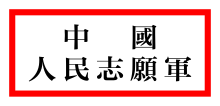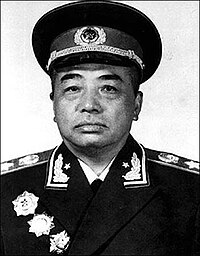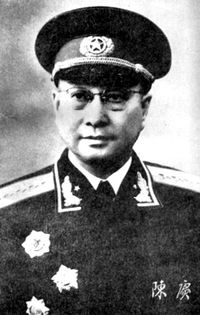
Back Popola Volontula Armeo Esperanto Ejército Popular de Voluntarios Spanish Armée des volontaires du peuple chinois French Tentara Sukarelawan Rakyat ID Esercito Popolare dei Volontari Italian 中国人民志願軍 Japanese 중국인민지원군 Korean Chińscy Ochotnicy Ludowi Polish Exército Voluntário do Povo Portuguese Китайские народные добровольцы Russian
This article includes a list of general references, but it lacks sufficient corresponding inline citations. (January 2010) |
| People's Volunteer Army | |
|---|---|
 People's Volunteer Army badge | |
| Active | 1950–1958 (combat troops) 1954–1994 (delegation) |
| Country | |
| Allegiance | |
| Branch | |
| Type | Combined armed forces |
| Role | Combined arms Defend North Korea Defend Northeast China Expeditionary warfare Short Attack |
| Size | +3 million troops[1] |
| Garrison/HQ | North Korea |
| Nickname(s) | 最可爱的人 (Most Beloved People) |
| Motto(s) | 抗美援朝,保家卫国 (English: "Resist U.S. and aid Korea, to defend our homeland") |
| Colors | Red |
| March | Battle Hymn of the Chinese People's Volunteer Army |
| Engagements | Korean War |
| Commanders | |
| Notable commanders | Peng Dehuai Chen Geng Deng Hua Hong Xuezhi Han Xianchu Song Shilun |
| People's Volunteer Army | |||||||||||||||
|---|---|---|---|---|---|---|---|---|---|---|---|---|---|---|---|
| Simplified Chinese | 中国人民志愿军 | ||||||||||||||
| Traditional Chinese | 中國人民志願軍 | ||||||||||||||
| Literal meaning | "China People Volunteering Army" | ||||||||||||||
| |||||||||||||||
The People's Volunteer Army (PVA), officially the Chinese People's Volunteers (CPV),[2][3] was the armed expeditionary forces deployed by the People's Republic of China during the Korean War.[4][note 1] Although all units in the PVA were actually transferred from the People's Liberation Army (PLA) under the orders of Chairman Mao Zedong, the PVA was separately constituted in order to prevent an official war with the United States. The PVA entered Korea on 19 October 1950 and completely withdrew by October 1958. The nominal commander and political commissar of the PVA was Peng Dehuai before the ceasefire agreement in 1953, although both Chen Geng and Deng Hua served as the acting commander and commissar after April 1952 following Peng's illness. The initial (25 October – 5 November 1950) units in the PVA included 38th, 39th, 40th, 42nd, 50th, 66th Corps; totalling 250,000 men. About 3 million Chinese civilian and military personnel had served in Korea throughout the war.
- ^ "Тараптардың күштері және шығындар". Archived from the original on September 29, 2013. Retrieved February 10, 2019.
- ^ "China welcomes return of CPV soldiers' remains for 10 consecutive years". english.www.gov.cn. Retrieved April 20, 2024.
- ^ "Identities of ten Chinese People's Volunteers martyrs confirmed - Ministry of National Defense". eng.mod.gov.cn. Retrieved April 20, 2024.
- ^ Shen Zhihua (沈志华) (2000). 《抗美援朝战争决策中的苏联因素》. 《当代中国史研究》, 1, 28–39.
Cite error: There are <ref group=note> tags on this page, but the references will not show without a {{reflist|group=note}} template (see the help page).


